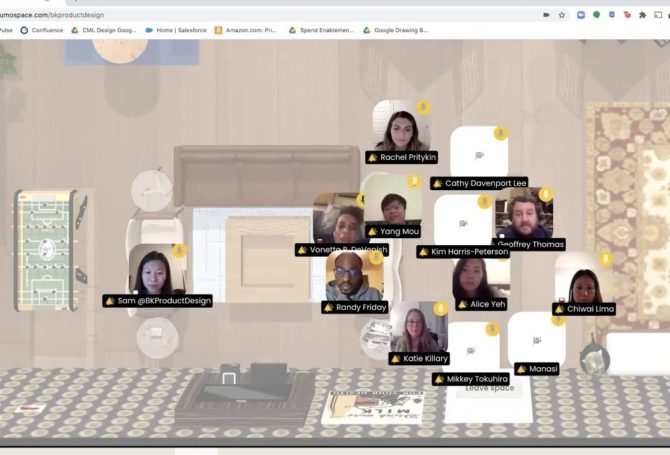
Video conferencing for many people has become a daily – and sometimes an all-day – occurrence. One way to break up the monotony of virtual meetings is to escape from grids of talking heads (and occasional flashes of pajama bottoms) to platforms that feature on-screen spatial mobility.
Remote work, made widely necessary by the COVID pandemic, has increased, not decreased productivity. But that has come at the expense of leisure time and informal workplace exchanges, where creative sparks can spontaneously ignite. Newer iterations of video conferencing platforms seek to restore that informality online – recreating the serendipity of the office water cooler.
Yiren Lu in The New York Times Magazine insightfully reviews a crop of new video conferencing platforms. “On Zoom, moving from one meeting to another means choosing which buttons to click. There’s no buffer for serendipity and fewer opportunities for bonding. Virtual communication software like Zoom and Slack [replace] only a sliver of what the in-person work experience had been like.” That’s the void second-generation video conferencing sites are trying to fill.
Gather.town is a recent video conferencing startup that features virtual maps where participants can figuratively move around to join different clusters of people in the same “meeting”. Not surprisingly, it is becoming the platform of choice for virtual happy hours and a socially distanced substitute for hanging out with friends and coworkers over lunch. The platform also presents itself as a virtual option for birthday parties, game nights, community spaces, walks in the park, campfires and movie nights. It offers “fluid video chat”, whiteboards for doodling and customized venues.
Lu cites other new entrants into the video conferencing marketplace, such as Hopin and Run the World, that cater to conferences and events. Run the World describes itself as a “one-stop-shop for experts, creators, community leaders and organizations to host and monetize interactive online events such as workshops, meetups, summits or shows.” It even provides a calculator to tote up how much you could make from selling tickets to one of its online events.
Hopin, founded in 1969, bills itself as the platform to “create virtual events people love”. It allows participants to move in and out of “rooms”, so someone attending a conference could arrange a one-on-one with a fellow attendee in a separate virtual area. Event organizers design their own virtual venue’s color schemes and schedules.
Teamflow creates virtual office settings for staff meetings. Remote workers have their own “desks” and can move around the “office” to check on co-workers, brainstorm with colleagues or just “bump” into someone in the virtual hallway.
Some platforms are all play and no work. Teleparty (formerly Netfix Party) enables synchronized group movie-watching. Kumospace bonding events occur in virtual living rooms, which Lu says resemble “glorified chat rooms”, except you can get a virtual drink in Kumospace that gradually empties as if you were really sipping it (and actually might be in the privacy of your own physical space). Pluto is a virtual-meeting platform that allows users to move around 3-D renderings of places like the Maldives, Admont Abbey in Austria and Burning Man, more or less like Peleton stationary bikes allow riders to cruise real trails or Tour de France routes.
Much of the inspiration for these new video conferencing options comes from online video games, which facilitate multi-player, multi-site engagement while enabling participants to interact with their own virtual space. “One of Kumospace’s insights is that video games give participants a goal around which to center their social energy,” Lu observes. “Among Us, a multiplayer game of deception, attests to the fact that virtual activities can generate real camaraderie.”
“A year of remote work has fundamentally shifted – or expanded – the kinds of decisions we’re willing to make without relying on in-person interaction, from fund-raising to sales to voting to making friends,” says Lu.

These videoconferencing platforms aren’t fly-by-night enterprises. Remote work is here (actually, out there) to stay. We can expect residual reluctance to business travel and large in-person conferences now that virtual options exist. Lu expects more innovations and new wrinkles to enhance the experience of virtual gatherings for work, learning or fun. Just as important, remote options expand capacity, break down distance barriers and potentially generate more revenue per event.
While we already are dependent on computers and mobile devices, remote gathering technology may accelerate virtual reality usage and spur technology companies to add virtual smell, touch and taste capability to our laptops and smartphones, further reducing the physical gap between in-person and online contact. As Lu observes, a good chunk of the work force is being conditioned now to accept virtual connections, despite what in a few years will be considered primitive video conferencing technology.
In post-pandemic normalcy, people will want to socialize, work together and attend conferences. But those get-togethers are likely to be more intentional than required attendance. They also may be enhanced by plugging in virtual participants and blending in-person and virtual engagement. Going to the office may have more meaning than just showing up on time. Video conferencing may offer its own reality.




